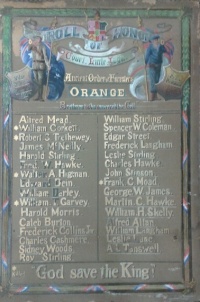Sidney Charles Woods
From The Orange Wiki
WOODS, Sidney Charles
Service no: 6357 [1]
Place of birth: Orange, 1889
Address: McLachlan Street, East Orange
Occupation: Miner
Next of kin: Mary Anne Woods (mother), McLachlan Street, East Orange, later Nile Street, East Orange
Date of enlistment: 9 May 1916
Place of enlistment: Dubbo
Age at enlistment: 28
Fate: Embarked HMAT A14 Euripides, Sydney, 9 September 1916. Disembarked Plymouth, 26 October 1916. Proceeded to No 3 camp, Fovant. Marched in to 1st Training Battalion, Perham Downs, 8 December 1916. Embarked SS Victoria, Folkestone, 15 February 1917. Marched in to Australian Infantry Base Depot, Etaples, 16 February 1917. Taken on strength, 2nd Battalion, 11 March 1917. Proceeded to reinforcement camp, France, 13 September 1917. Rejoined battalion 25 September 1917. Proceeded to UK on furlough 3 February 1918. Rejoined battalion, France, 18 February 1918. Killed in action, France, 17 April 1918.
Date of death: 17 April 1918
Buried: Outtersteene Communal Cemetery Extension, Bailleul, France, Plot II, Row G, Grave 15
On 15 July 1918 the SS Barunga was hit by a torpedo from a German submarine off the coast of Cornwall. Nearby destroyers rushed to the rescue and managed to save all 800 sick and wounded Australian soldiers aboard, who were on their way home from the war. The vessel was also transporting many packages containing the personal effects of soldiers who had died in service for delivery to their next of kin. Among them were the last possessions of Sidney Charles Woods and William Alexander Woods, brothers who were killed on the Western Front nine days apart. When the Barunga sank so too did William and Sidney’s personal effects, never to be recovered.
Sidney was born in Orange in 1889, the youngest son of William and Mary Ann Woods. When he enlisted for service in May 1916 he was living with his mother in McLachlan Street, East Orange, and working as a miner. He was also a member of the Ancient Order of Foresters.
Sidney embarked from Sydney in September 1916, a private in the 2nd Battalion, 20th Reinforcement. He spent several months undertaking further training at the 1st Training Battalion at Perham Downs before proceeding to France in February 1917. He served on the Western Front for a full year before proceeding to England for two weeks leave.
In February 1918 Sidney rejoined his battalion in France. Two months later, on 17 April, he was inside a barn at Sec Bois near Hazebrouck in Northern France when it was hit by a German shell, killing him. Sidney was buried the same day at Outtersteene Communal Cemetery Extension at Bailleul.
According to Sidney’s commanding officer, Lieutenant HW Parle:
- Pte Woods was considered by my fellow officers and myself, who he was under for several months,
- to be a splendid soldier and an example to others. Needless to say his death was regretted by all
Sidney Charles Woods is commemorated on the Ancient Order of Foresters Orange Roll of Honor, the Holy Trinity Church Orange Honour Roll, the World War I Roll of Honour on the southern face of the Orange Cenotaph and on panel number 35 on the Roll of Honour at the Australian War Memorial in Canberra.
In 1923 the Anzac Memorial Avenue of trees was planted along Bathurst Road to commemorate fallen WWI soldiers. A tree was planted in honour of “Gunner SC Woods”; it was donated by Orange District School. Very few of the trees are still standing today.


